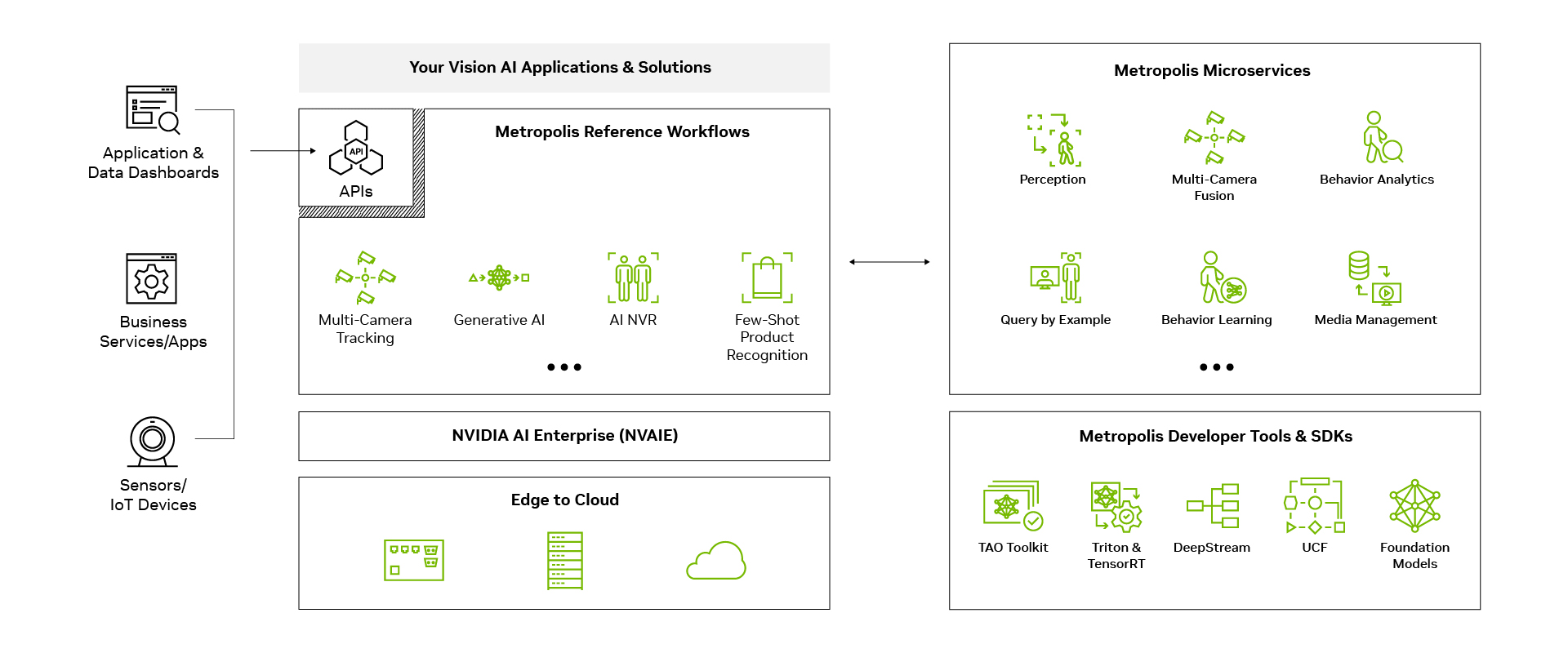Software Toolkits
NVIDIA Metropolis Microservices
NVIDIA Metropolis Microservices provides a comprehensive and scalable set of tools and services that enable developers to quickly build and deploy advanced vision AI applications. By leveraging cloud-native architecture, modular design, and a broad ecosystem, developers can easily deploy and manage their AI solutions across various environments

Key Features and Capabilities
- Cloud-Native and Scalable Architecture: Metropolis Microservices utilize industry-standard technologies such as Docker, Kubernetes, and REST APIs, enabling seamless and scalable deployment across environments, from edge devices to cloud platforms. This flexibility supports applications running on NVIDIA Jetson, x86 servers, and GPUs in data centers.
- Modular and Reusable Components: The microservices are designed to be modular, allowing developers to integrate and customize them for a wide range of use cases. This modularity means that once you develop a component, it can be reused across different applications, enhancing efficiency and reducing development time.
- Comprehensive Vision AI Workflows: The platform includes pre-built reference applications and workflows, such as multi-camera tracking, occupancy analytics, and retail loss prevention. These workflows serve as starting points for developers, allowing them to quickly build and deploy sophisticated vision AI solutions.
- Advanced AI and Machine Learning Capabilities: NVIDIA integrates powerful AI features like generative AI and behavior analytics. These capabilities include detecting and tracking objects across multiple cameras, analyzing behaviors and anomalies, and performing high-throughput similarity searches. This helps in gaining deeper insights and predictive analytics from video data.
- Enhanced Edge-to-Cloud Connectivity: The platform supports edge-to-cloud connectivity, facilitating seamless data streaming and AI inferencing. This ensures that vision AI applications can be deployed and managed efficiently across diverse and geographically dispersed locations.
- Support for Digital Twins and Synthetic Data: NVIDIA’s Metropolis platform leverages digital twins and synthetic data generation to improve model robustness and streamline the development process. This is crucial for testing and validating AI models in controlled, simulated environments before deploying them in real-world scenarios.
- Extensive Ecosystem and Integration Options: The microservices are compatible with a wide range of NVIDIA technologies and SDKs, such as TensorRT、DeepStream, and the TAO Toolkit, providing a comprehensive ecosystem for developers to build and optimize their vision AI applications.
》Highlight – Discover Real-Time Cross-Camera Insights
Reimagine your space with state-of-the-art, multi-camera tracking (MTMC) or vision-based real-time locating system (RTLS) technology. They go beyond single-camera perception to enable real-time insights for vast areas.
The NVIDIA system takes advantage of digital twins to simplify complex workflows, from synthetic data generation to model validation and facilitating rapid deployment. Discover patterns, optimize workflows, and enhance safety in your facilities with cutting-edge vision AI.
Use Cases
- Retail Analytics: Applications for monitoring customer behavior, preventing theft, and optimizing store layouts using multi-camera tracking and real-time analytics.
- Smart Cities: Managing traffic flows, monitoring public safety, and enhancing urban infrastructure through AI-driven video analysis.
- Healthcare and Industrial Automation: Utilizing vision AI for patient monitoring, process optimization, and safety management in hospitals and industrial settings.

